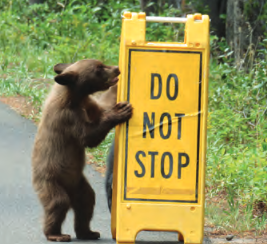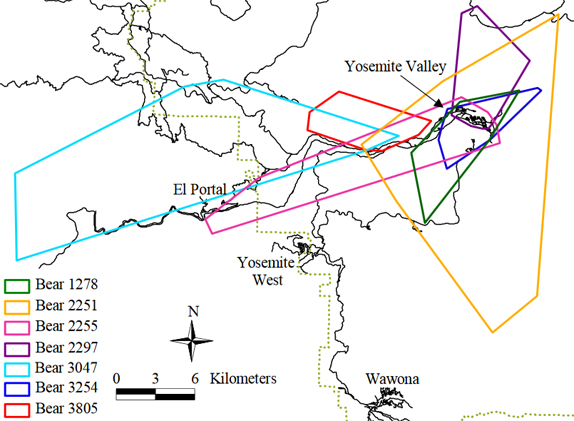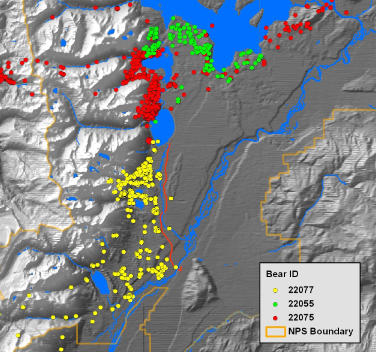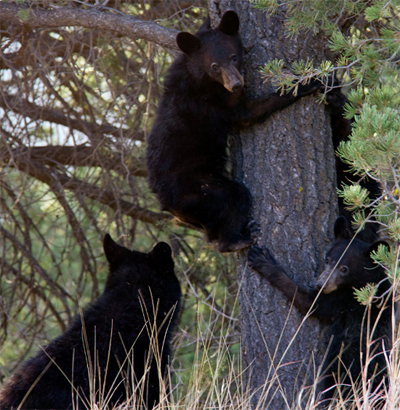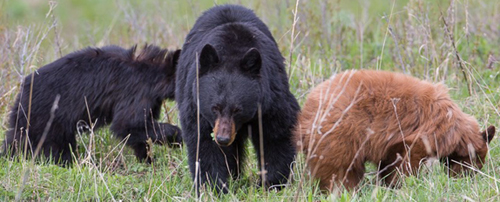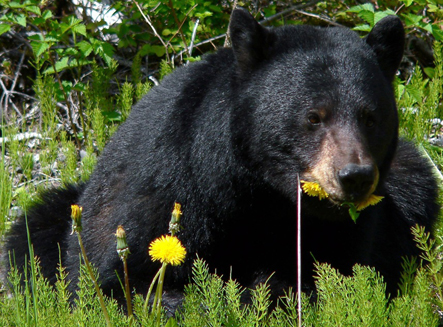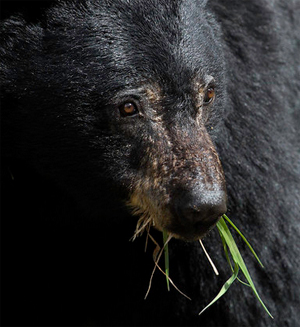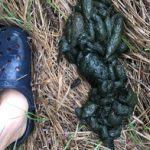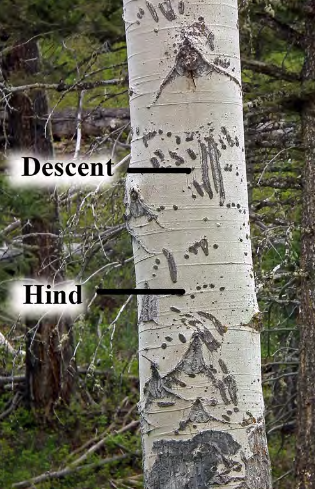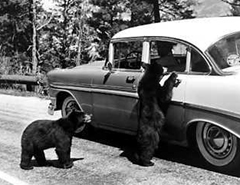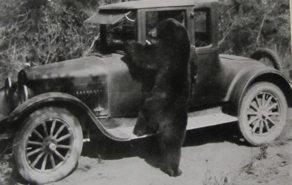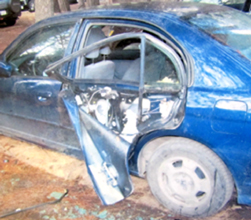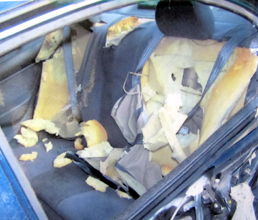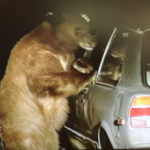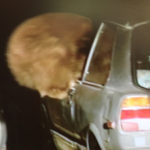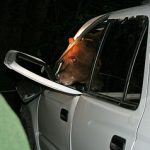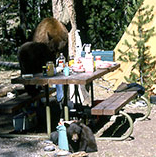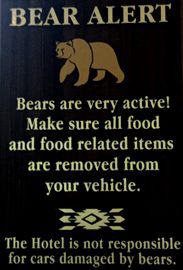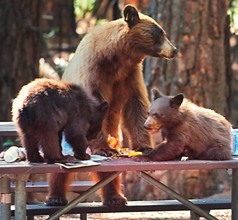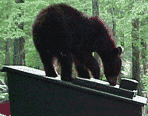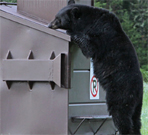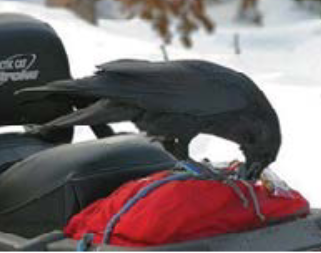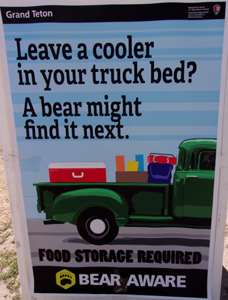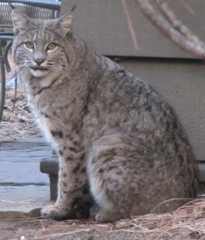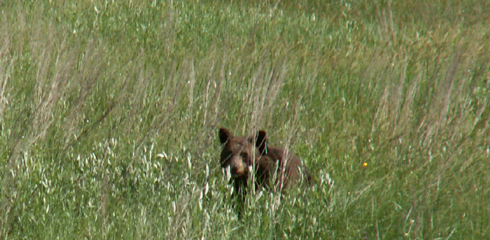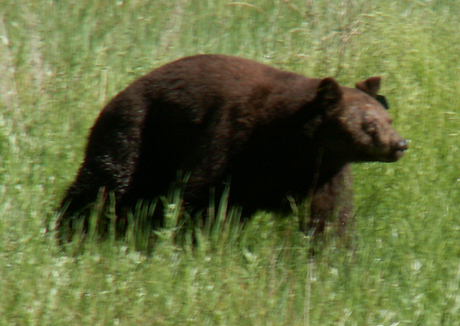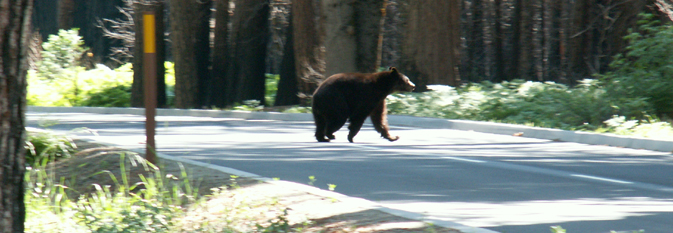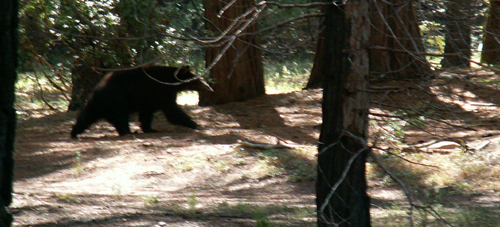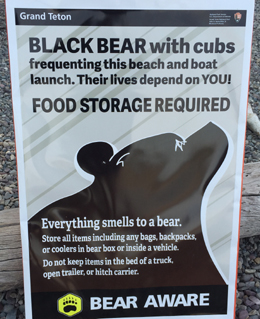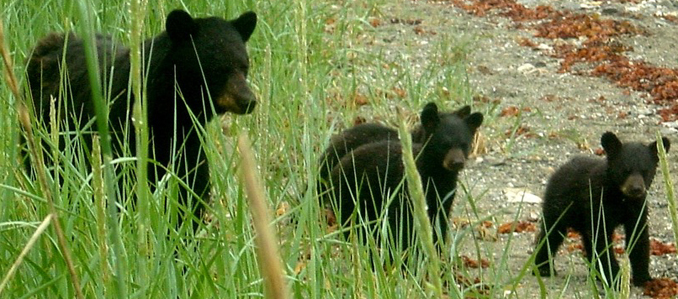bear looking into a car window:
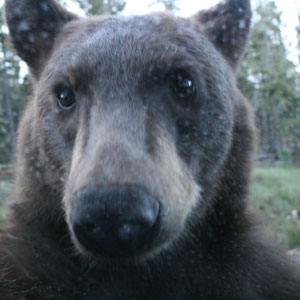
links to general info about bears,
then practicalities of camping and backpacking around bears, (Food Storage , what to do if you see a bear, how bears get into cars, info for backpackers) and lots of stories about bears getting into cars, tents, camps, etc., mostly geared towards De Anza College Outdoor Club trips around bears in California and Grand Teton National park.
And the answer to the question:
Why don’t the rangers just move the problem bears?
And this first section on Black bear activity in Yosemite:
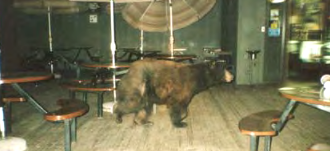
Black bear activity in Yosemite, including number of incidents, is reported (as often as possible) at
http://www.nps.gov/yose/planyourvisit/bearfacts.htm
http://www.nps.gov/yose/learn/nature/bear-management.htm
and you can find Yosemite Daily Report listings of Bear Incidents and Total Property Damage, plus how and where incidents happen, by various months and years from the late 1990s to recent years, at Black Bear Management Trends.
Yosemite Conservancy donors, like yours truly, get regular news briefs, including that “New GPS collars and hand-held data-collection devices will replace older, outdated models and allow wildlife managers to gather invaluable real-time information about bear habitat and behavior.”

https://www.yosemiteconservancy.org/wildlife-management/keep-bears-wild-GPS-tracking-2016
This shows tracking for one bear crossing a road back and forth during one day, while looking for food. (A reminder to please drive slowly.)
and a new page for 2017: “Bear Tracker displays data transmitted via satellite from the Bear Team’s state-of-the-art GPS bear collars, making it available to you to remotely explore the lives of these amazing animals. How far do bears move in a day? How big are their home ranges? When and where did the last vehicle-bear collision occur in the park?” http://keepbearswild.org/bear-tracker/
and read lots of stories at: http://keepbearswild.org/bear-team-blog/
Bears have various sizes of territories that can change from year to year:
And here, from a NPS report,
the dots represent GPS positions from 3 black bear collars retrieved in Grand Teton National Park:
“Yosemite’s black bear is an omnivore commonly spotted eating berries in the summer or acorns in the fall. Yosemite’s largest mammal, the male black bear weighs an average 300 to 350 pounds, and smaller females weigh 150 to 200 pounds. The biggest black bear ever captured in Yosemite weighed 690 pounds. If visitors spot a bear while in the park, it is a black bear-not a brown or grizzly bear. The last known grizzly bear was shot outside the Yosemite region in the early 1920s; the species no longer exists in California despite its presence on the California state flag.”
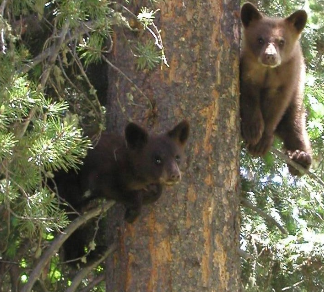
– – – from a Yosemite Daily report:
“In fall months, in preparation for hibernation, bears eat up to 20,000 calories every day – that’s like eating nine large cheese pizzas, about 35 medium bean and cheese burritos, or 93 Snickers bars every single day! In terms of a bear’s natural diet, that’s equal to over 11 pounds of acorns, or around 100 pounds of berries.”
– – from a Yosemite Daily report:
“Tool use was first documented in wild brown bear (Ursus arctos) in southeastern Alaska in 2012 when a subadult was observed using barnacle-encrusted rocks to scratch its neck.”
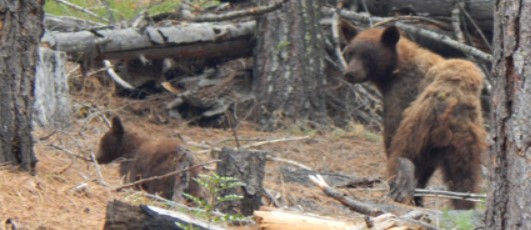
– – – from a Yosemite Daily report:
“Yosemite National Park is home to between 300 and 500 American black bears. Despite their name, most of Yosemite’s black bears are actually brown in color. Black bears are incredibly strong, curious and intelligent animals. They are fast sprinters, agile climbers,
excellent swimmers
and quick learners with an extraordinary sense of smell — and a huge appetite. The average female bear weighs 150 pounds and males often exceed 300 pounds. The average lifespan is 18 years in the wild. Black bears naturally avoid humans, but when they learn to associate food with people, that behavior can change quickly, which is why vigilance and proper food storage are so important.”
Bears see in color, have excellent night vision and hear in our normal range as well as the ultrasonic range.
Bears can run as fast as 35 mph. The average human athlete runs at around 15 mph, and the fastest known human (Olympic gold medalist Usain Bolt) runs at 27 mph.
Bears win.
– – – from a Yosemite Daily report:
A bear’s sense of smell is believed to be the best of all terrestrial mammals, estimated to be ~2,100x stronger than ours and measured to be capable of picking up on scents 1-3 miles away. With that in mind and the population density of black bears in Yosemite being approximately 1 bear per square mile, at least 1 bear is smelling you at all times while in Yosemite.
And from Ranger notes: “Looking at a black bear’s head, it’s obvious that they have a very large nose. The area inside a black bear’s nose, called the nasal mucosa, is 100 times greater than ours. This large nose results in an excellent sense of smell! Even bloodhounds, dogs so famous for their sense of smell that they’re used to track missing people, don’t smell as well a black bear. It is estimated that black bears’ sense of smell is about seven times greater than a bloodhound’s.
A black bear’s sense of smell is so good that it’s difficult to measure. Bears are commonly thought to have the keenest sense of smell in the animal kingdom, and estimates of the range of their sense of smell vary widely. Conservative estimates of a black bear’s sense of smell state that a black bear can smell a food source from over a mile away, while other sources claim a black bear can smell food from over two miles away.
The one extant species of bear in Yosemite National Park (the American black bear, Ursus americanus) is found only on the North American continent.
“Male black bears rarely reach 400 pounds (180 kg) and females may grow to 250 (112.5 kg)
“Black bears in the Sierra Nevada usually den from mid-December into March or early April. This time period is shorter than in areas with harsher winters.
“If a sow is healthy enough, she will give birth during hibernation inside the den in late January or February.” Bear milk provides three times the energy when compared to human milk and contains 30-33% fat on average compared to about 3-4% fat of human milk.
“Meadow plants, grasses and tender herbs are the most important food source before the berries and nuts ripen in late summer.”
“Despite their name, the coat color of black bears range from yellow through various shades of brown to black. About 95% of bears in the Sierra Nevada are some shade of brown and only about 5% are a true black color. ”
Yellowstone park reports that “about 50% of black bears are black in color, while others are brown, blond, and cinnamon.”
Bears are often seen in movies and television standing on their two hind legs, growling and looking quite ferocious. In real life however, black bears stand bipedal when they are trying to get a better look or smell at something that has peaked their curiosity, and growling is rarely a sound that you will hear from a black bear.
They also note that “while a vast majority of the Sierra black bear population lives an entire 10-30 year lifespan without coming into contact with humans, others are not so fortunate. Some black bears in the Sierra Nevada have learned to capitalize on opportunities to dine on unprotected garbage sources or food that has been left unsecured.”
Denali Park explains why a bear would stand up:
“If a bear stands up and looks at me, is it acting aggressively?
No. Bears stand on their hind legs in order to get a better look or a better whiff of something they are not sure of. If this happens, make it obvious that you are human by waving your arms and speaking loudly. Try to position yourself so that you are upwind and the bear can smell you. Signs that a bear is disturbed by your presence include: woofing, jaw chomping, swaying, laying ears back, and yawning.”

The guiding principle of the Sierra Interagency Black Bear Group is to
never underestimate an animal you can teach to ride a bicycle…
From Yosemite National park, Bear Facts – August 15-21, 2004
“Bears express themselves vocally. Many visitors have been treated to a late night wake up by a bear moaning in the tree above their tent. The moaning is a display of disappointment. Also, bears often huff while in the tree as a show of annoyance. This week we saw two bears in one tree. One was moaning and the other was huffing!”
Bear sounds from the NPS:
https://www.nps.gov/subjects/bears/sounds.htm

A report from Grand Teton National Park listed what they found in grizzly bear scat:
“A recent synthesis of the available literature on grizzly bear diets (Gunther et al. 2014) determined that the most frequently detected items in 11,478 scats collected during 37 years between 1943 to 2009 were graminoids [grasses], 58.7%; ants, 15.8%; whitebark pine seeds, 15.4%; clover, 11.19%; and dandelion, 10.9%. Other items frequently detected were elk, 8.3%; thistle, 6.9%; horsetail, 5.6%; yampa roots, 4.9%; berries, 4.9%; cutthroat trout, 4.4%; biscuit root, 4.0%; spring beauty, 2.9%; bison, 2.8%; and fireweed, 2.7%. The review also noted the annual stability of the most frequently detected diet‐items during 33 years between 1943 and 2009. The most stable items were graminoids, ants, and elk, which were found in the collected scats in all years (100% of years); clover was present during 97% of years; and elk, thistle and horsetail were found in 94% of years.”
Yellowstone park wrote abut the differences in black bears and grizzly bear diets: “The primary difference is that meat and roots are less prominent in the diet of black bears (Knight et al. 1988). Black bears have short, curved claws better suited for climbing than digging. In contrast, grizzly bears have longer, straighter claws and a larger shoulder muscle mass which makes them more efficient at digging for food items in the soil such as roots, bulbs, corms, and tubers, as well as rodents and their caches (Herrero 1978). Overall, grizzly bears consume more meat and black bears more plant material.”
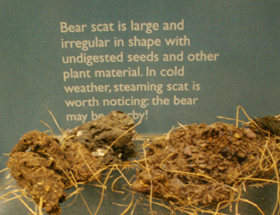
bear scat (left hand photo is full of berries, right hand photo is glossy dark green, common when bears eat a lot of grass
see also: animal sign comparisons
Bears climb trees easily.
These next two photos of bear cubs are courtesy of Tom Ingram Photography, all rights reserved tomingramphotography
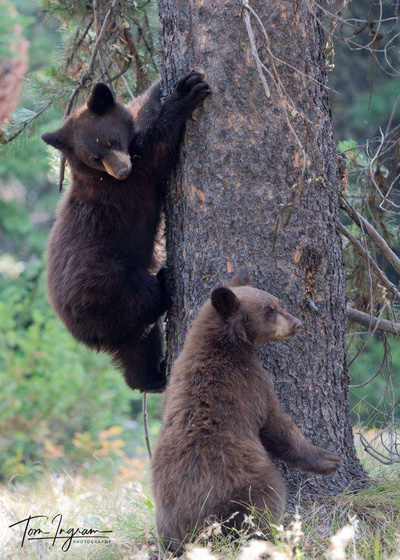
![]()
Bears leave signs when they scratch on trees and when they climb up and down them. This tree trunk has vertical scratch marks made by a bear during descent. The arc of five scars was made by the jab of a hind foot directly into the trunk during ascent.
and here are the size of scratch marks a bear left on a tree in relation to a human hand:
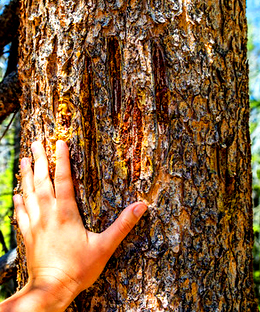
From the Yosemite Daily report:
“Bears shed (molt) their fur annually during the spring and summer. Often times, the new fur is a darker color. The molt generally starts around the feet and head. During the different stages of the molt, bears sometimes appear to have on socks or have a bleached ‘Mohawk’ down their back.”
“Cubs are born in January or February weighing approximately 8 ounces. When they emerge from the den with their mother about 3 months later they weigh 10-12 lbs. Cubs generally stay with their mother until the end of their second spring. Yearlings are currently separating from their mothers and will be seen alone in the park. They are often mistaken for cubs due to their small size, usually weighing between 50-90 lbs.”
“Bears are capable of standing upright on their hind legs. They stand unaided to observe or increase sight distance, to fight, and to reach to feed, prey, or mark. Bears do not attack in this position, though they may raise their upper body to better reach and grasp their prey or enemy. The American black bear can walk bipedally, but only for a few steps.”
“While searching for insects, a black bear yearling was observed flipping over a 320 pound rock using only a single foreleg. This young bear weighed only 120 pounds.”
“Black bears have a ‘mean curiosity index‘ of 59, beating out weasels, otters, dogs, raccoons, and cats.”
These photos are from the National Park Service historic photo collection:
There are an estimated 350 to 500 black bears in Yosemite National Park. 10-20 of them are tagged.
They can live to 20 or 30 years old. They are black bears, but are 90% brown in color (or red, blonde, black), often with a white blaze on their chest.
Hibernation depends on food availability, not weather, and some do not hibernate much at all. They pick a den that is warm and dry, including even up in a hole in an oak tree. Adult males go into hibernation first and are first out. They start to go out in March. Females with cubs are the last out of hibernation.
They eat 4,000 calories a day.
They are incredibly quiet when walking and can sneak up and get food off a picnic table that people were sitting at. Injuries to humans include at night when unloading food into the campsite bear box, and the doors are open, and the person gets swatted by a bear that snuck up on them.
More human food = more tooth decay.
A well fed mother might have 3-4 cubs. Her body delays implantation and her body knows how many she can have. A sow not well fed might have only one cub or none. There might be cubs from different fathers in one birth.
Black bears are strong enough to bend open an improperly latched bear box door.
Bears have an powerful sense of smell. For example, they can smell a banana in an ice chest in the closed trunk of a vehicle. To get at that banana, a bear broke into a door window and clawed through the backseat.
39 black bears were hit by vehicles in Yosemite in 2015, the highest number to that date. (Average was previously 19 per year.)

Alaska National Parks note:
“Bears Don’t Like Surprises
If you are hiking through bear country, make your presence known – especially where the terrain or vegetation makes it hard to see. Make noise, sing, talk loudly. If possible, travel with a group. Groups are noisier and easier for bears to detect. Avoid thick brush. If you can’t, try to walk with the wind at your back so your scent will warn bears of your presence. Contrary to popular belief, bears can see almost as well as people, but trust their noses much more than their eyes or ears. Always let bears know you are there.”
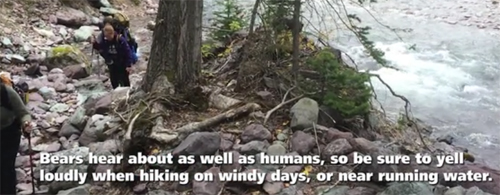
Bear “bells” do not work at all well compared to a human voice. They don’t carry over streams, wind as well. Instead talk loudly, sing, shout, clap hands or otherwise make noise on the trail.
The NPS says:
“When hiking, periodically yell “Hey bear!” to alert bears to your presence, especially when walking through dense vegetation/blind spots, traveling upwind, near loud streams, or on windy days. Avoid thick brush whenever possible.”
“Bear bells may be a popular item to put on your backpack, but they don’t effectively warn a bear you’re in the area. Bears won’t hear the bells until you’re too close. Yelling, clapping, and talking are more effective ways of alerting a bear to your presence.”
Glacier Park warns:
“Make Noise
Bears will usually move out of the way if they hear people approaching. Most bells are not enough. Calling out and clapping at regular intervals are better ways to make your presence known.
Do your best to never surprise a bear.”
Bears usually stay away from people, but sometimes like to use trails.
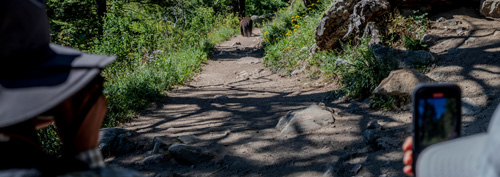
But if you see a juvenile bear on a trail like this, mom is likely very nearby and very protective.
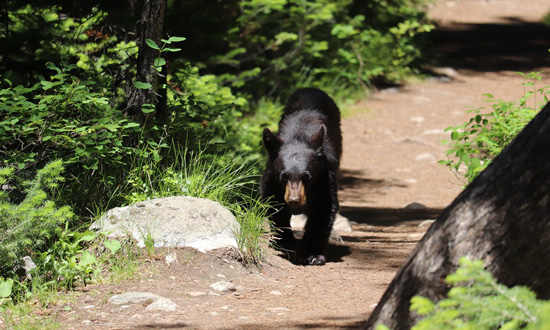
You could go to an area / trailhead you have often visited and find a warning you must heed:
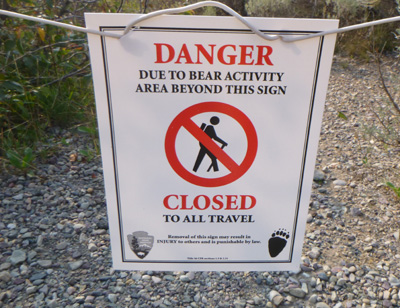

The Yosemite National Park rangers would like you to call them
if you see a bear in Yosemite,
no matter where it is or what it is doing.
Since 2003 there has been a note in the Yosemite Guide: “REPORT ALL BEAR SIGHTINGS! To report bear sightings, improper food storage, trash problems, and other bear-related problems, leave a message for the Bear Management team at: 1 (209) 372-0322. Your call can be made anonymously.”
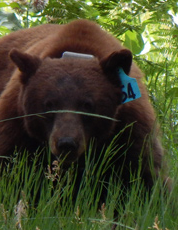
If you can, in all the excitement, try to notice if the bear has a tag (usually on the ear), the color of the tag and if possible, the number on it (the tag is large enough that with a telephoto lens you should be able to read the number).
The NPS notes: “Tagged, or radio collared, bears do not mean the bear is a “bad” bear. Tagging bears is done for better monitoring, and the ear tag color is completely random, used to help quickly identify a bear.”
From the Yosemite Daily Report newspaper:
“It is extremely important to remember to yell at bears that are in and around development, even if they are foraging on natural food. Though it is very tempting to get close for a picture, or just to watch these incredible animals, it is important not to give into this urge. Yelling at them if they are in residential areas or near people is critical to keep bears natural fear of humans. Giving bears plenty of space. When bears become too comfortable around people, they will often start causing damage to structures and vehicles, or will even become too bold around people, creating safety concerns.”
And the Yosemite Daily Report also said:
“Scare bears when you see them. . . in developed areas- Yell like you mean it!
Make as much noise as possible, try waving your arms, stomping your feet
or anything to make you look intimidating and to get the bear to run away.
We know it’s fun to see bears and it can feel mean to scare them,
but this is a simple way to truly help save a bear’s life.”



https://www.nps.gov/media/video/view.htm?id=2D267AA8-E839-8F9A-D30823F8F6F5B6DA
or
https://www.yosemiteconservancy.org/yosemite-nature-notes-black-bears
The main method is by putting their claws into the top of your door frame and pulling down on the door, much like the lid on a sardine can opens.
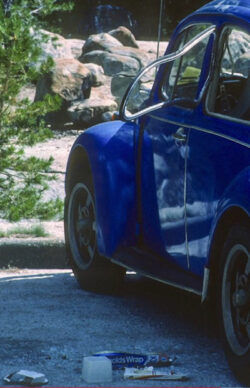
Once in the car sometimes they will claw through the back seat to get into the trunk, or with some models, they can pull the back seat open as the owner would. Another method is to bust your tailight out and reach into the trunk.
Black bears may prefer minivans, either for easier access or because they often carry food-spilling children in them, causing more food odors.
The abstract of
Selective Foraging for Anthropogenic Resources by Black Bears: Minivans in Yosemite National Park
said: “Black bears (Ursus americanus) forage selectively in natural environments. To determine if bears also forage selectively for anthropogenic resources we analyzed data on vehicles broken into by bears from Yosemite National Park, California. We classified vehicles into 9 categories based on their make and model and collected data on use (2001–2007) and availability (2004–2005). From 2001 to 2007 bears broke into 908 vehicles at the following rates: minivan (26.0%), sport–utility vehicle (22.5%), small car (17.1%), sedan (13.7%), truck (11.9%), van (4.2%), sports car (1.7%), coupe (1.7%), and station wagon (1.4%). Only use of minivans (29%) during 2004–2005 was significantly higher than expected (7%). We discuss several competing hypotheses about why bears selected minivans. . .
and also in the article:
. . . There are several non–mutually exclusive hypotheses for why bears selected minivans.
First, it is possible that minivans were more likely to emit food odors regardless of whether they contained meaningful amounts of food available. This argument is based on the fact that minivans are designed for families with children and small children in particular are notorious for spilling food and drink while riding in vehicles.
Thus, vehicles transporting children would emit greater food odors, making them attractive to bears. If this hypothesis is correct then any vehicle transporting small children, regardless of class type, should be targeted by bears. To test this supposition, park personnel collecting information on vehicles broken into should also note whether car seats were present, or whether small children are regularly transported in the vehicle, or both.
Second, it is possible that passengers of minivans were more prone to leave large caches of food (e.g., coolers or grocery bags) in vehicles parked overnight. Evidence from the incident reports (Table 2) supports this contention by indicating that most vehicles broken into (regardless of vehicle class) had evidence of available food. What is unknown from these reports is the amount and type of food available, which could vary from microtrash resulting from children to large quantities of food such as coolers or grocery bags. Passengers of all vehicles entering Yosemite National Park are exposed to the same educational material regarding storing food in food lockers rather than vehicles and it is difficult to imagine why drivers of minivans would be biased toward leaving food in their vehicles. Additional data to evaluate this hypothesis could include the quantity and types of food present in incidents.
Third, it is possible that minivans were structurally easier to break into than other vehicles. Our observations indicate that bears entering minivans typically did so by popping open a rear side window and it seems that this was easier for minivans compared to other vehicle classes. We note that bears are strong and well equipped (long claws) to open a variety of structurally sound materials (e.g., logs and ant mounds), and we commonly saw car doors bent open, windows on all sides of the vehicle broken, and seats ripped out, all of which appeared effortless for bears. . . ”
http://jmammal.oxfordjournals.org/content/90/5/1041
Please do note that simply because some models
might be more difficult to break into,
every vehicle is a potential target.
(One bear broke into a car for just a power bar wrapper.)
Leaving your dog in the car will not scare off the bear. One morning at the Yosemite Ahwahnee Hotel, a bellman found a car broken into by a bear the night before. An empty ice chest had been showing (and smelling to a bear) through the back window. The large family dog was cowering and whining under the steering wheel column.
(as well as removing and properly storing all scented items, etc.).
One who let himself in by opening an unlocked door became trapped in a car and was found sleeping on the back seat in the morning, but most who get stuck inside panic and tear up/destroy the vehicle interior trying to get out, including setting off side air bags and getting even more panicked.
The Truckee, California, police said of bears who broke into cars and locked themselves in: “Bears can manipulate car handles if the cars are left unlocked. . . After the bears go in, they may pull the door on themselves – that makes them stressed and causes them to thrash around, which can cause quite a bit of damage inside.”
A Steamboat Springs, Colorado newspaper report said: “Steamboat’s black bears have learned to open” (unlocked) “car doors, especially Subarus. Their door handles allow bears to wedge their paws in and pull the handle. Sometimes, the door will close behind the bear and trap it.”
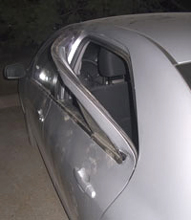
From a park service video played at visitor centers, a car door bent open by a bear, and the car owner trying to bend the door back
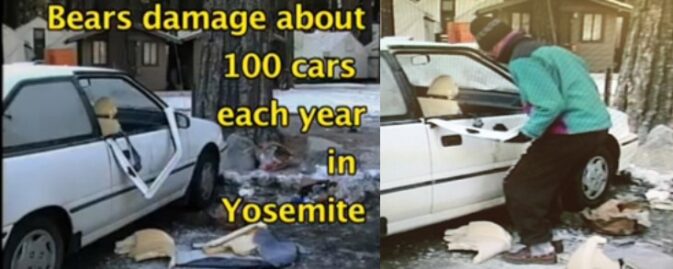
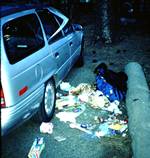
From The Bear Facts (July 13 – July 19, 2003)
“Six vehicles were damaged by a bear in the Curry Village area last week, all vehicles contained food.
From the Daily Report of Thursday, July 31, 2003
Bears broke in to twenty vehicles last week, many containing a significant amount of human food. Most of the damage occurred in the Curry Village parking lots and at the Ahwahnee Hotel.
Park Service photos or photos from a video played at visitor centers:
To see bears breaking into cars and get the most current advice, watch the video at:
http://www.nps.gov/media/video/view.htm?id=FDE421A6-91D6-8489-2DF28939BB23391D
I put park press releases about bear damage statistics and a link to the possible answer to why black bears so often choose minivans at:
Black Bear Management Trends
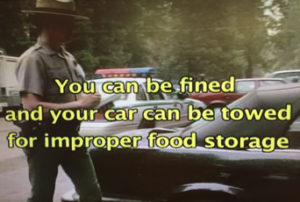
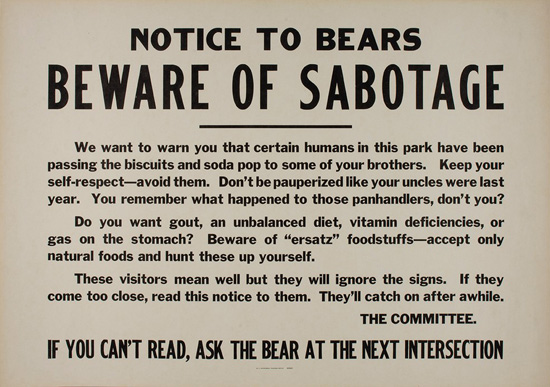
At times in the 1990s, 10 to 15 cars would be ransacked in a night. In 2000, bears broke into more than 300 cars, smashing windows, clawing doors open and ransacking the interiors, (according to the San Francisco Chronicle).
breaking into your vehicle:
Besides getting everything with a scent out of your vehicle when you arrive in the park (see Food Storage below),
Before the trip (you can’t trust your own nose); look around the car, including under the seats, thoroughly, for that dried up french fry or stick of gum that fell under the seat. Take the gum wrappers out of the ashtray. Hey, no heavily scented air fresheners hanging from the rear-view mirror! Puuuuuulease get rid of the dashboard hula girl that emits the pina colada scent, (only $2.99 at the Frys one day Flash Sale and you couldn’t resist).
Check the glove compartment.
The child seat has food spilled on it, but scrubbing it before the trip might not be enough. You might need to try to clean it and then leave it sitting out, perhaps on the picnic table overnight.
Remove night crawlers and salmon eggs from the fishing gear.
No bottle of brake fluid or spray can of deicer showing, the bears don’t know it’s not food and will break into your car because they see an item the shape of a food container.
A day pack/backpack is a food container to a bear. Leaving an empty one, even a brand new one that has never had snacks in it, on the front seat could cause a break-in. The best policy is to have your car interior cleaned out of all gear visible through the windows or have everything covered. (After you first remove ALL the scented things.)
(Bears have excellent vision and can see in color.)
Look for anything the shape of a food container. In Glacier Park a bear bit a plastic diesel fuel can in a pickup truck bed, causing a leak.
Bears have an incredible sense of smell and are able to smell things 3 miles away, so they can smell food in your trunk.
Air out your car if you eat burgers on the way to the park.
A good way to wake up the whole campground is to set your car alarm. Then if a curious animal or clumsy person bumps the vehicle at night you’ve succeeded.
(A car alarm won’t keep bears out of your vehicle).
below a warning note a Tuolumne ranger put on a car (not one of ours) and a bear’s eye view in the window:
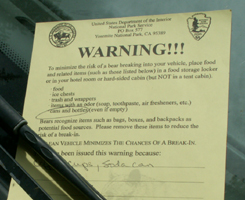

Bears can get into locked rooftop car storage pods.
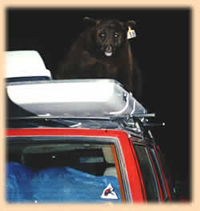
“If a bear approaches or touches your car, honk your horn and drive away to discourage this behavior.
On Saturday, May 11, a black bear in the Tower-Roosevelt area put its paws on vehicles.
In May of 2018, a black bear previously fed by people in the Mammoth Hot Springs area approached a vehicle, put its paws on a door and looked into the vehicle’s windows. Also last May, a grizzly bear near Yellowstone Lake went up to a car and played with its antenna.
Bears that grow accustomed to people and view humans as a food source can become aggressive and have to be killed.”
“A small grizzly bear weighing approximately 150 pounds, entered the Many Glacier Campground. It crossed a stream, entered a campsite, and compelled two campers to move away from a picnic table where they were cleaning two recently caught Brook Trout. One of the campers sprayed the bear with bear spray from a distance of 15 feet. The spray was unsuccessful in deterring the bear’s approach, and it proceeded to climb on top of the picnic table and consume the fish. It also sniffed, pawed, and bit two nearby backpacks.
Park rangers responded and used hazing techniques to encourage the bear to move out of the campground. Prior to its departure, it dug into two fire pits, sniffed picnic tables, a tent, and an RV with visitors inside.”
and see: http://keepbearswild.org/food-storage/
” Yosemite National Park is home to hundreds of American black bears; these bears have a voracious appetite. They also are incredibly curious and have an amazing sense of smell. This combination sometimes leads them to look for our high-calorie food. Sometimes bears that routinely get our food become aggressive, and sometimes have to be killed as a result. By storing your food properly, you can prevent a bear’s unnecessary death.
Please note that these food storage regulations have the force and effect of federal law:
Failure to store your food properly may result in impoundment of your food or car and/or a fine of up to $5,000 and revocation of your camping permit”
What is food?
“Food” includes any item with a scent, regardless of packaging. This may include items that you do not consider food, such as canned goods, bottles, drinks, soaps, cosmetics, toiletries, trash, ice chests (even when empty, and even if certified as bear resistant), and unwashed items used for preparing or eating meals. All these items must be stored properly.
How to Store Your Food . . .
Cars, Trucks, and RVs
During daylight hours only, you may store food inside your car or truck (out of sight, with windows completely closed).
Do not leave food in a pickup truck bed or strapped to the outside of a vehicle at any time.
Do not store food in your car (including trunk) or truck after dark: use a food locker. Remember to clear your car of food wrappers, crumbs in baby seats, and baby wipes–and even canned food and drinks. Think about packing all your food and related items together for easy removal from your car upon arriving in Yosemite.
Food lockers are available at Curry Village parking lots and at nearly all trailhead parking areas.
You may store food out of sight in hard-sided trailers and RVs, as long as windows, doors, and vents are closed when you’re not there. Hard-sided RVs are those made entirely of solid, non-pliable material (e.g., no cloth pop-outs) Food may not be stored in pop-up or tent trailers, or other soft-sided campers.
You must store all your food in food lockers. Bears may enter campsites even in your presence, and some will even check lockers to see if they’re latched.
Keep your locker closed and latched at all times, just like you would a freezer.
Only have the food out that you are actually using; if you’re not using it, put it back into the food locker.
Finally, treat your trash like food: keep it in your food locker or dispose of it in a bear-proof dumpster; do not leave it sitting out.
Food lockers are available at every campsite, Housekeeping unit, and Curry Village tent cabin.
Food may be stored out of sight in hard-sided trailers and RVs, as long as windows, doors, and vents are closed when you’re not there. Food may not be stored in pop-up or tent trailers, or other soft-sided campers.”
Hotel Rooms and Cabins
You must keep all food inside your room; if you are not in the room, the windows and doors must be closed. Bears can easily break into cabins through an open door or open window.
Picnicking and Hiking
Always keep your food within arm’s reach and don’t turn your back to your food; never leave food unattended. Bears may investigate picnic areas or backpacks for food even in your presence, so be alert.
Backpacking in the Wilderness
You are required by federal regulations to store all your “food” properly throughout Yosemite National Park. You must have your food stored unless it’s within arm’s reach (so, don’t go for a swim or take a nap while leaving food out).
“Food” includes all food and drinks, regardless of packaging, along with trash, toiletries, and other scented items. These items must be stored in either an allowed bear-resistant food container or food locker. Hanging food is illegal throughout Yosemite. . .
Bear resistant food containers (“bear canisters“) are required for overnight hikers throughout the Wilderness (counterbalance food hangs are no longer legal). In Yosemite and the southern Sierra, bear canisters are the only effective and proven method of preventing bears from getting human food.
Treat odorous products such as soap, toothpaste, fuel products, suntan lotion, candles, and bug repellent in the same manner as food . . .
trash and recyclables; water bottles; stoves and grills; dishes, utensils and washbasins; pet food and bowls.

If animals get anything from you, NEVER try to get it back from them until they abandon it. Immediately clean up any scattered garbage or food.
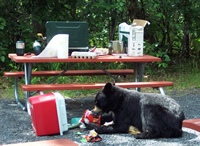
Especially after dark, don’t turn your back on food and don’t leave a bear box in a campground open beyond the time it takes to get out what you need. If you arrive after dark, keep someone with the gear in the back of the pickup until you can unload and store it properly. At the very least, raccoons might be climbing into the back of the truck.
At bedtime, double check pants/jacket/day pack pockets for spare chocolate bars.
At bedtime, use a flashlight (electric torch) to check under the picnic table for lost potato chips and cooking items you forgot you set down on the ground during cooking. Below: a cook set down a container of pasta sauce under a picnic table bench on one of our winter trips and forgot about it. We found it with a quick flashlight sweep before we all moved to the campfire.
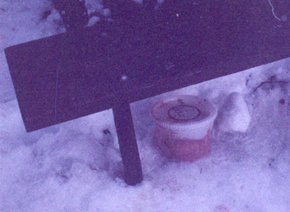
_____________________________________________________________________
Logistics on fitting everything in a campsite food storage locker, especially with a big group, are at: Using a campsite food storage locker
From The Bear Facts (July 13 – July 19, 2003)
A large untagged/uncollared bear has been seen in Upper Pines and the Wilderness Lot, checking for improperly latched food storage lockers. Visitors have reported this bear going from site to site, banging on the locker latch. Unfortunately, the bear obtained food on at least three occasions from improperly latched lockers.”
and from Yosemite Bear Facts — October 20, 2024
“Bear Activity Summary: So far this year, about one third of bear incidents have occurred in Yosemite’s residential areas, another third have happened in wilderness, and the rest were in various frontcountry areas. This highlights the important impact we all have on wildlife in Yosemite both living here and visiting the park. Constant diligence with your food storage is important and can have drastic impacts on the lives of the bears that live here.
Bears this time of year are spending the majority of their time eating, trying to pack on pounds for hibernation. Acorns are a primary food source for bears in the fall, and the crop of acorns is particularly large this year. Bear activity has been picking back up in Yosemite Valley the past couple of weeks, with a bear getting into a food storage locker that was not properly latched this week.”
How to use the latches is at: Yosemite bear-proof food locker latching systems
Please use the clip on the trash bin to lock it. If a bear gets into a dumpster on a hot day it can be a death trap.
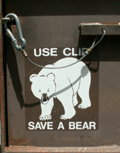
If you notice one is un-clipped, please clip it.
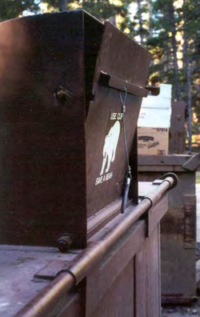
Immediately report it to a hotel front desk, ranger or campground host if the clip is missing from the dumpster.
Before clips to hold dumpster lids shut, bears have been trapped in dumpsters. A ranger wrote in his blog: one bear “ended up wandering around the Mariposa County landfill. A few bears have (spectacularly) escaped from trash trucks after being dumped into them. In any case, now dumpsters have clips (but not everyone bothers to use them).”
In the photo above, the note on it says:
“Dumpster Full
This dumpster is full and has been wired shut to prevent black bears from accessing the overflow trash. Please do your part in protecting Yosemite wildlife by finding another dumpster to dispose of your trash. Thank you.”
PLEASE, when a dumpster is full don’t just leave your trash sitting next to it, or try to stuff it in,
find another dumpster.
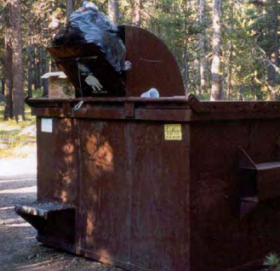
When a trash bin at an outside dining area is full, find another trash bin rather than piling trash on top, and report it to the management:
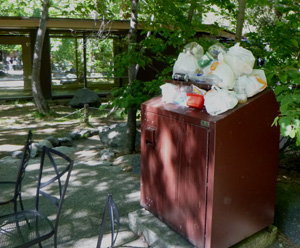

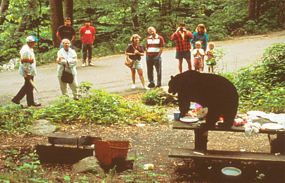
FAQ: How can I keep bears or coyotes or raccoons or … animals out of my campsite?
You can’t.
A bear may enter your campsite day or night, even in the presence of many people, dog(s) even large ones, a big campfire or lots of lights, even motion sensor lights/flashing strobe lights. Running your vehicle engine or generator, playing loud music, motion-activated sound systems simulating a barking dog and/or gunshots, trying various ‘repellents’ (mothballs, an open bleach container, pine-scented cleaner, fabric softener sheets or ammonia soaked rags hanging everywhere, dog or cat in-the-garden repellent, etc.) will not work.
Some places would sell you a “perimeter trip wire alarm device.” Some offer to sell you a pad you can put on the ground next to your tent or a fence to put around your campsite that will produce an electric shock. These could injure you neighbors, children, or even you.
Trying to set an alarm (pots and pans stacked on top of a cooler, for example), might wake you up when a bear investigates the cooler, but will not give you enough time/any way to keep the animal from getting the food.
In Yosemite National Park, it is prohibited to possess or use pepper spray (including bear spray and other irritant gas devices), including ones you might have purchased for a trip to a park in the rocky mountains.
Don’t try spraying bear spray on your tent, clothes, etc. Glacier Park warns: “It” (bear spray) “is not intended to act as a repellent. Pre-sprayed objects may actually attract bears.”
a sign at a Grand Teton National park visitor center:
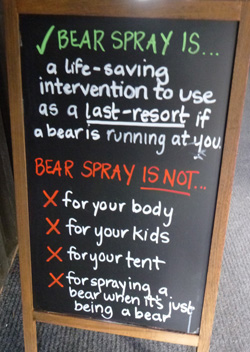
_____________________________________________________________________
From a Yosemite Daily Report (2004) “Stay close to your food, and put it away as soon as you are finished eating. Bears may enter picnic areas, even when people are present, so be prepared to repel them.”
From a Yosemite Daily Report of June, 2004:
Bears are getting food from visitors that are too far from their food. (Farther than arms length is too far and any food behind the back is an invitation.)
___________________________________________________________
At the edge of some campgrounds you might see a trap:
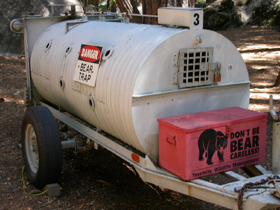
“You may not see a bear during your visit because bears naturally avoid people. If you do see a bear, what you should do depends on the situation. In any case, always let a ranger know or leave a message at 209/372-0322. If a bear is attempting to get human food or won’t leave a developed area, you can call 911.
Bear in a Developed Area or Approaching You
If a bear approaches you or if you are in a campground, picnic area, parking lot, lodging area, or other developed area, act immediately to scare it away. Scare the bear away by yelling aggressively and as loudly as possible until the bear leaves. The bear is intruding on your personal space: act angry and be persistent. If you are with other people, stand together to present a more intimidating figure, but do not surround the bear. While never a guarantee, these techniques are highly effective when done well. (Bear spray/pepper spray is not allowed in Yosemite.)
If you have food out and are having trouble scaring the bear away, pack up all your food and leave the area. Throwing food at the bear or leaving food behind will only encourage its behavior and likely result in the bear’s death. Never have out more food than you can control and do not leave food out of arm’s reach, even for a moment. (Do not try to take back food that a bear already has.)
The purpose of yelling aggressively is not to harm the bear, but to scare it from the area and restore its natural fear of people by providing a negative experience. Scaring a bear away, along with storing your food properly, helps keeps bears wild and alive.
Bear Outside Developed Areas and Not Approaching People
If you see a bear away from development and people, keep your distance (at least 50 yards, or about the distance four shuttle buses parked end to end would take up). If you get closer, you will be helping the bear become used to being around people.
Bears that become comfortable around people lose their natural fear of us and sometimes become too aggressive; sometimes they then have to be killed.
When a ranger sees a bear, the ranger may use non-lethal aversive tactics to chase the bear out of a developed area. During your visit, you may see and hear rangers patrolling public areas for bears. You may hear rangers yelling at and chasing bears. You may also see or hear rangers shooting noisemakers or non-lethal projectiles (such as rubber slugs from a shotgun or clear paintballs from a paintball gun). The intent is not to harm the bear, but to scare it from the area and restore its natural fear of people by providing a negative experience.
NOTE: These regulations and precautions help decrease the chance of personal injury or property damage. However, bear damage and confrontations are still possible even when all of the above guidelines are followed. Failure to comply with these regulations may result in citation and/or impoundment of property.”
_____________________________________________________________________
(If you act to to scare a bear away, give the bear a wide, w i d e path to run away).
Don’t do any of this if you are between a mama bear and her cub(s), or more importantly, NEVER get between mama and her cub(s).
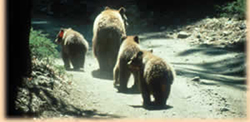
________________________________________________________________
Bears hibernate all winter, so food storage isn’t as important then, right?
WRONG. The bears don’t truly hibernate all winter in mild winter places like Yosemite and the food storage rules are in effect all year.
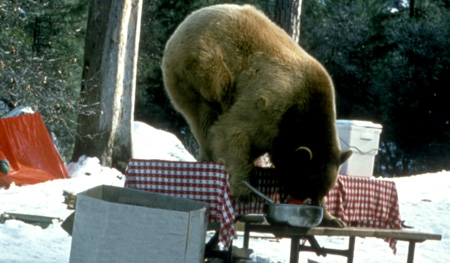
We saw bear tracks in the snow in Yosemite on a January Ranger snowshoe walk, and one broke into a car (not one of ours) during our Feb. 1999 trip. (And there have been other winter break-ins we might not personally have heard of).
In Feb. 2019 we compared our hand sizes to bear paw prints in the snow on the grounds of the Ahwahnee Hotel:
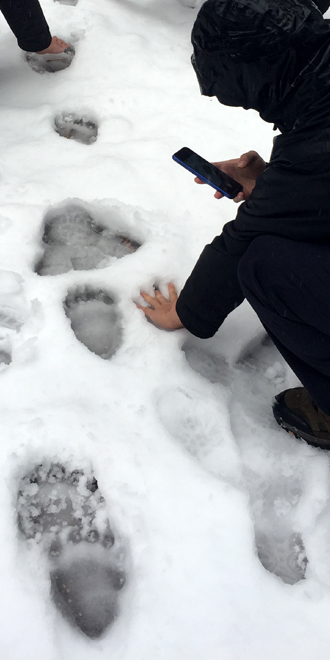
Plus, the raccoons and coyotes are everywhere in the campground in winter, especially at night. Raccoons know how to unzip tent doors.
Mid-November 2004, with 17 inches of snow on the ground at Tuolumne, the rangers reported:
“Tracey stepped out of the ski hut and nearly hit a small Black Bear with the door one evening. We have been seeing this bruin’s tracks for the last week visiting all the buildings, garbage cans and recycle cans in the Tuolumne and Tenaya area. Although there are no rewards habits die hard.”
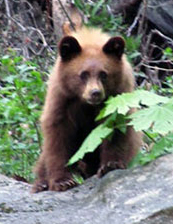
There is a lot more at: Backpacking Advice, including thunderstorms, menu ideas and no-cook backpacking food, ways to keep down on weight and more.
From the website in 2016, 7, 8, 2019:
“While backpacking in the Wilderness
Bear resistant food containers (“bear canisters”) are required for overnight hikers throughout the Wilderness (counterbalance food hangs are no longer legal). In Yosemite and the southern Sierra, bear canisters are the only effective and proven method of preventing bears from getting human food.”
and in 2025:
“You are required by federal regulations to store all your “food” properly throughout Yosemite National Park. You must have your food stored unless it’s within arm’s reach (so, don’t go for a swim or take a nap while leaving food out).
“Food” includes all food and drinks, regardless of packaging, along with trash, toiletries, and other scented items. These items must be stored in either an allowed bear-resistant food container or food locker. Hanging food is illegal throughout Yosemite.”
https://www.nps.gov/yose/planyourvisit/bearcans.htm
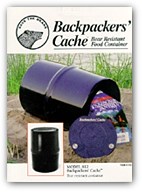
(Some bear resistant food containers have been invented made of Kevlar, fabric and/or fabric aluminum have been invented, but are not allowed at many parks. Check in advance to see which brands of hard plastic models are okay where you go. https://www.nps.gov/yose/planyourvisit/bearcans.htm)
Rent a bear can in Yosemite: https://www.nps.gov/yose/planyourvisit/bearcanrentals.htm
Yosemite backpackers pages start at: http://www.nps.gov/yose/planyourvisit/backpacking.htm
Grand Teton backpackers pages start at: http://www.nps.gov/grte/planyourvisit/back.htm
“There is a bear frequenting the Mist trail. It has been observed with in a few feet of visitors! This is not o.k.! Please be sure to keep your food with arms reach when you sit down for lunch or look for a place to water the plants. Also, if a bear approaches you, make loud noises. Throw small sticks or stones towards the bear (aiming only for the rear of the bear and choosing smaller than quarter size stones). Always leave the bear an escape route. While this bear may seem tame, she is not. She is a wild animal with unpredictable behavior. Help save her life. Do not feed her and do not approach her.”
From The Bear Facts (July 13 – July 19, 2003)
“Several bears continue to obtain food from backpackers in the Little Yosemite Valley area, including the Sunrise Creek and Moraine Dome area. One bear has learned to snatch backpacks containing food from unsuspecting hikers who have left their packs on the ground while pumping water or using the restroom. Another bear has learned to intimidate campers, snatching their open bear canisters if they show signs of backing down. It is important for backpackers and hikers to always be aware of their surroundings and to watch for sneaky bears.”
From July, 2004 Yosemite daily report:
“Two yearlings are approaching visitors for food on the trail to Half Dome.
No matter how small, bears can be dangerous. Bears have been obtaining food left at the Half Dome junction. If you drop your pack to go up the dome, please take all food with you or leave in a canister away from your pack.”
Think you can outwit the bears by using some other method or other bear resistant container design than the approved containers? If you try and fail it could mean the bear will keep on trying to get human food and may have to be put to death. Zoos don’t want them and when the park tries to relocate them the mostly come back to where they found easy human food sources, or die trying to.
Bears are very smart animals. The bear ‘proof’ garbage bins have been redesigned many times by the park service. Bears have been used in circuses around the world because of their brains and gymnastic abilities. In backpacking areas some have been known to keep up the circus tradition by climbing on limbs above a suspended food bag and leaping to snag it with their claws on the way to the ground, so hanging food is no longer allowed in Yosemite and many other camping areas. Rock climbers occasionally report that bears pulled up food bags they hung over sheer rock cliffs. Bears don’t mind water and have swum out to a raft people thought they could hide food on .
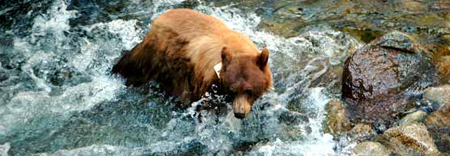

Previously many parks trapped bears that got in trouble and relocated them.
![]()
Yellowstone Park says this about why they do not try to relocate bears:
“Yellowstone National Park does not typically relocate bears for three reasons: 1) there are no areas in the park to move the bear where it wouldn’t have the continued opportunity to potentially injure someone and damage property, 2) surrounding states do not want food-conditioned bears relocated into their jurisdictions, and 3) adult bears have large home ranges, good memories, and could easily return to the original area.”
At the top of the stairs at the beginning of the portage trail from Leigh Lake to String Lake in Grand Teton park there’s a bear box (standard metal footlocker style) with a sign on it reminding people to put all their food in it while they carry their canoe/kayak down the trail instead of leaving food sitting out unprotected.

On a trip a few years back in Grand Teton the rangers were prohibiting picnics in one popular area because a mom bear was teaching her cub to bluff charge picnickers to scare them away from their food.
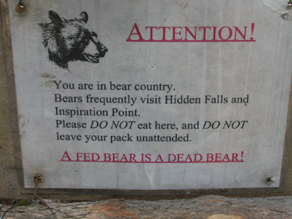
Below, a picture of a display in Grand Teton showing a fuel bottle with hole where a bear bit into it.
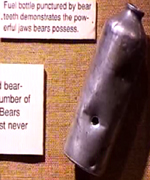
“Food Storage while Climbing in Yosemite.
Bears actively seek food left by climbers at the base of climbs. Do not leave any food, drinks, toiletries, or trash at the base of the wall. All food must be stored in an allowed bear canister or hung well up the cliff face (if you can reach food without climbing gear, so can a bear).
Each year, bears rip into numerous haul bags and packs at the base of various climbs. Every time they get food from a haul bag or backpack, they become more conditioned to human food. Help us break this cycle! Store all scented items properly at all times!
The Rules and Reasons
Never stash food unless it is properly stored: either in an allowed bear canister (available for rent at any wilderness center for $5) or hung well off the ground on vertical rock. If you can reach your food (or the rope tying it off) without climbing gear, it is not stored properly.
This includes daylight hours! If you are cragging at the base, the same rules apply: carry your food with you or rent a bear canister for $5. (Do not hang your food in a tree–it’s illegal and useless.)
Remove all food, drinks, toiletries, and trash from your car. Food lockers are available at the El Capitan Picnic Area (Manure Pile) and on the south side of El Capitan Bridge. Please do not lock these shared lockers.
If protecting these animals isn’t enough to motivate you, maybe a citation will do the trick. If your food is stored improperly, you will be cited for improper food storage (fine of up to $5,000).”
(2016, not at the Food Storage while Climbing page in 2017, 2018 or 2019)
If you leave food in a bear box near a trailhead or climb, please leave a note attached with your intended dates of storage so a Ranger won’t clean is up when it looks like it has been abandoned.
Besides the food lockers (bear boxes) listed above, you can find more at trailheads listed here:
https://www.nps.gov/yose/planyourvisit/trailheads.htm
Each trailhead should have some bear boxes (food lockers), except as noted in the charts.

Yellowstone (black and grizzly) bear encounters info is at:
http://www.nps.gov/yell/planyourvisit/bearenc.htm
For our trips to Grand Teton National park, some required reading:
your safety in grizzly bear territory
Why don’t the rangers just move the problem bears?
Daily Report – Yosemite National Park
Tuesday, June 13, 2006
In the last month, we moved 4 yearlings to various locations outside of the Valley (but inside the park). They were moved in an effort to help them establish home ranges full of natural foods, rather than remain in Yosemite Valley where they are in close proximity to many sources of human food. So far these bears have not returned to the Valley, although they have traveled quite a bit. As a contrast, we moved an adult female this week that had already established her territory in the Valley. She returned in two days! This is why we rarely move adult bears-it’s a lot of work and they come back almost faster than we do.
and:
“Approximately 80% of relocations of adults fail. The failure comes in many forms. Most bears just return and continue to seek out human food. Some bears wander outside of the park boundaries and cause problems in places that are not equipped the bear proof facilities we have in the park. When this happens, they are often destroyed by California Fish and Game. Also, bears can wander outside the park boundary and be hunted. Finally, the bear population in California is very healthy, so when you move a bear, it is likely there is already a bear in that area that knows the good food sources. The new bear is forced to compete for a limited food source in a place it’s never been.
With yearling and subadult bears, there can be some success in moving (up to 40%), because they haven’t established their home range as clearly as adults.”
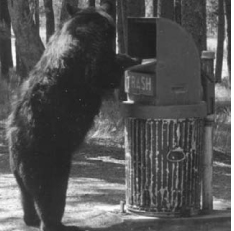
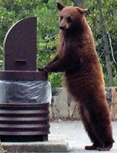
From the San Francisco Chronicle – June 6, 2004
People Create Bear Problem
by Tom Stienstra
In my latest visit to Yosemite this weekend, I’ve concluded it’s unlikely the bear problem will ever be solved here. There were 13 more bear incidents reported in the past week, bringing the total to 60 already for the spring season, up 97 percent from last year.
You probably know why, of course. It’s always been a people problem, not a bear problem.
For most park visitors, the bears resemble cartoon characters; seeing one validates the vacation. I’ve seen experienced campers on their last night leave out an open tub of butter on a picnic table to entice a bear into their camp, impress the family and get pictures.
Hey, if you were a bear, what would you rather eat? Grass, ants, termites and bugs under rocks, or a tub of butter?
At Yosemite, Yogi is definitely smarter than your average bear. Bears learn quickly each June that they can just amble into a campsite at about 8 p. m., merely glance at the day’s newly arrived campers, elicit shrieks and shouts and then nab any leftovers sitting out.
The bears are like UPS drivers on their rounds, going from campsite to campsite, with each bear working its nightly route. “So, whatcha got for little ol’ me?” Every day, a new camper shows up, and the shock-and-awe effect usually nets at least a leftover hot dog…
…Then there is the story of the tourists from Europe who didn’t think it was so funny.
This was in Wawona in south Yosemite, where the four tourists charged into the ranger station, shouting in hysterics that their “rental car had been bombed by terrorists.” The proof, they said, was the “powder residue from the explosive” all over the back seat.
Rangers examined the crime scene and discovered that the “powder residue” was actually pancake mix — along with a paw print in the middle of the back seat.
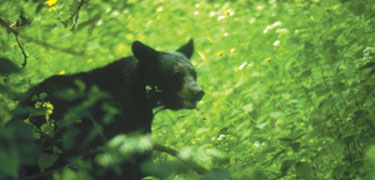
Again, keep your food within arms reach, and stay with any bags / coolers in truck beds, tied to vehicle tops when you arrive until you can get them properly stored.
Early Saturday morning on the De Anza College Outdoor Club 2013 winter Yosemite trip we found a torn open pack sitting just outside the entrance to one of the two-person tents. A raccoon had opened the tent and dragged it out, not even waking the people inside. In the second photo, the camper, not knowing how his pack got there, was concerned that perhaps his camera had been stolen, but that was not what the raccoon wanted. In the foreground of the third picture you can see the yellow chocolate bar wrapper (he and the raccoon share a liking for Toblerone bars). Yes, everyone had been asked to triple check their day packs, pockets, etc., before putting gear in their tents. Yes, this has happened more than once.
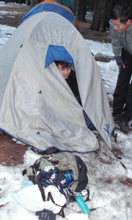
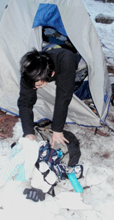
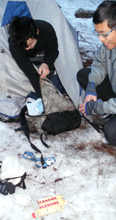
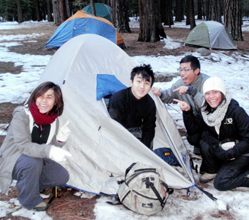
On the 2010 winter trip a guy put one of those suitcase mini-locks on the zipper pulls of his tent, thinking that it would keep a raccoon out. The raccoon just tore the tent fabric instead.
For a laugh, read more at: Camping Blunders
_____________________________________________________________________
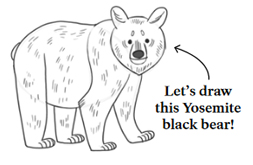
How to draw a bear:
https://www.nps.gov/yose/planyourvisit/upload/howtodrawabear-1.pdf
_____________________________________________________________________
Bears are common all over in Yosemite National park, but are shy of humans and most visitors will probably not see one as often as they might see a raccoon or coyote.
Likewise, bobcats live in Yosemite, but are not always seen by visitors. But check out this bobcat sitting by cottage 707 of the Ahwahnee Hotel:
The lab results of scat samples “for 2019 revealed that 35 individual mountain lions were detected in Yosemite: 14 females, 10 males, and 11 cougar samples without individual or sex identified.”
We did not notice the tag on the ear until we looked at our photos.
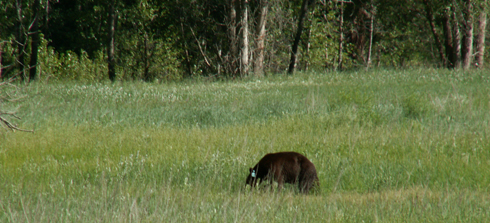
We watched this one for at least 20 minutes, and s/he did notice us, but we stayed still, then other not-very-quiet people came along and the bear noticed them and moved out of the meadow.
We saw where the bear was heading and had time to carefully stop oncoming traffic on southside drive before the bear crossed the road
and watched as s/he went up into the forest across the road.
First-timer’s instructions has instructions for beginning snow campers for the De Anza College Outdoor Club winter trip. Experienced people will probably pick up a few useful ideas.
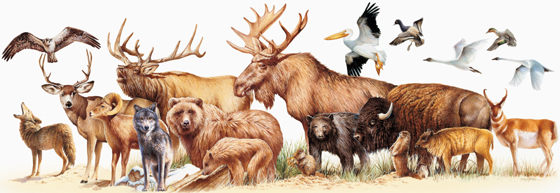 Rocky Mountain mammal size comparisons has photos and comparisons of beavers, squirrels, pika, marmot, elk, moose, bison, fox, coyote, wolf, golden-mantled ground squirrel, chipmunk, Red Squirrel (also known as) Chickaree, Unita Ground squirrels, bobcat, lynx, mountain lion (cougar), pine marten, mountain goats, bighorn sheep, pronghorn, grizzly and black bears.
Rocky Mountain mammal size comparisons has photos and comparisons of beavers, squirrels, pika, marmot, elk, moose, bison, fox, coyote, wolf, golden-mantled ground squirrel, chipmunk, Red Squirrel (also known as) Chickaree, Unita Ground squirrels, bobcat, lynx, mountain lion (cougar), pine marten, mountain goats, bighorn sheep, pronghorn, grizzly and black bears.

and How to not collide with a deer (or with a bear) with your vehicle. Yup, you might guess that doing the speed limit could be the most important thing.
Grand Teton National Park Media Release Oct. 11, 2018
Visitors Feed Black Bears
Adult Bear Euthanized and Cubs Relocated
MOOSE, WY- Two visitors to Grand Teton National Park were recently cited for illegally feeding wildlife within the park. On Thursday, October 4, visitors in two separate vehicles along the Signal Mountain Road were observed feeding fruit to three black bears. The bears, a sow and two cubs of the year, each received several food rewards during the incident and made contact with several vehicles along the road. The maximum penalty for feeding park wildlife is a $5,000 fine and up to six months in jail.
Grand Teton National Park Deputy Superintendent Gopaul Noojibail said, “Feeding wildlife in a national park is a serious offense and presents severe risks to the animal and to humans. Human carelessness doesn’t just endanger humans, it can result in an animal’s death.”
Feeding wildlife creates a safety risk for humans as animals associate people with food; bears can also become aggressive in seeking additional food, especially when preparing to den for the winter. Animals that are fed by humans also have an increased likelihood of being drawn to roadways and killed by vehicles.
Since June, these bears have been frequenting several developed areas in the Signal Mountain vicinity in very close proximity to people. Park staff and volunteers spent hundreds of hours trying to keep park visitors and these bears at safe distances from each other, near a busy park campground and lodging area. The female had three cubs born this year, but by late summer the bear was seen with only two cubs. The fate of the third cub is unknown.
In early August, two people sitting on the beach near Signal Mountain Boat Launch were startled by the bears and left a pack unattended. The sow found and ate an apple from the pack.
Due to the bears’ comfort with humans in developed areas, and, most importantly, behaviors that associated humans with food, posing an unacceptable risk to public safety, the three bears were captured and removed from the park. It was a difficult decision for park managers, who are responsible for the welfare of both wildlife and people in the park. The loss of these animals removes the opportunity for this bear family to contribute to a healthy, wild population and for visitors to enjoy them in their natural setting.
The adult female, approximately 4-5 years of age, was not a good candidate for an educational or zoo facility and was euthanized. The opportunity to place wild bears in an accredited facility is not always an option. The cubs are being relocated to Oswald Bear Ranch in Newberry, Michigan. The facility provides educational opportunities about bears and information about how to protect their natural environment. Park staff followed National Park Service policies as well as guidance from agency veterinarian to conduct all actions in a humane manner.
Grand Teton National Park educates visitors to act responsibly around wildlife to have safe and enjoyable park experiences. Information about regulations regarding safe viewing distances, not feeding wildlife, food storage and following speed limits are shared via park publications, informational signs, social media and web posts, ranger-led programs, and by the park’s wildlife brigade. Many park partners and local community organizations also communicate these messages. All park visitors are reminded to follow regulations related to human and wildlife safety.
This next photo is courtesy of Tom Ingram Photography, all rights reserved tomingramphotography
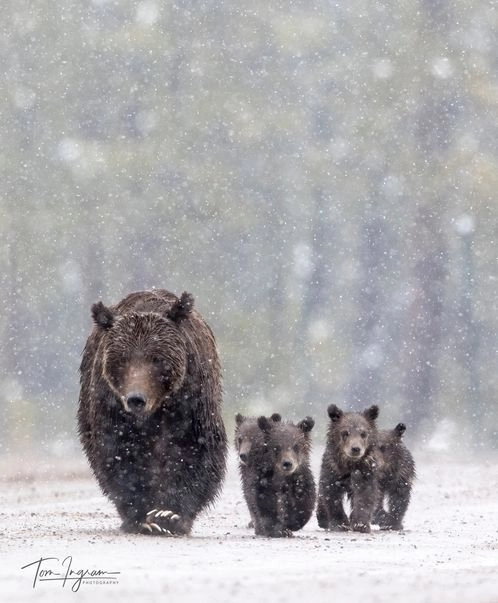
He wrote about taking this photo: “Grizzly 399 is the most famous bear in the world and inhabits Grand Teton National Park and Bridger-Teton National Forest. She surprised everyone in the Spring of 2020 when, at the age of 24, she emerged from her den along Pilgrim Creek with her four cubs. The news got out just days after she was first spotted, and I jumped in my car on a 14-hour drive to go see her. I arrived during a spring snowstorm and was thrilled to have quickly found her. This photo was taken in late May 2020 as she confidently walked toward me on Dump Road. I used a 500mm lens with a 1.4 extender (700mm effective length) while laying on my belly in a puddle of freezing water. I snapped this photo as she approached approximately 120 yards away. This photo was awarded second place in the international “Share the View” competition.”

For info about bear spray use see your safety in grizzly bear territory
Please watch this video provided by Yellowstone Park of Kerry Gunther, a Yellowstone National Park Bear Management Biologist, demonstrating how to use bear spray:
In a dozen years of club trips to Grand Teton National Park, no one has had to use (spray) any bear spray, but we always carry it.

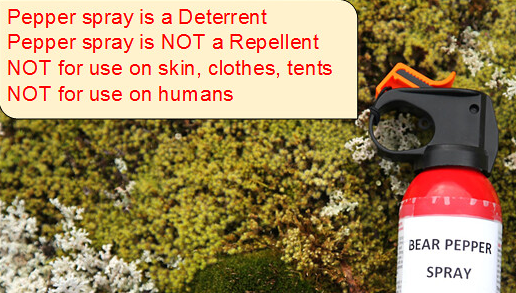
Do not spray bear spray on your tent, clothes, etc. Glacier Park warns: “It” (bear spray) “is not intended to act as a repellent. Pre-sprayed objects may actually attract bears.” . . .
Sign in a shower in Jenny Lake Campground, Grand Teton National Park:
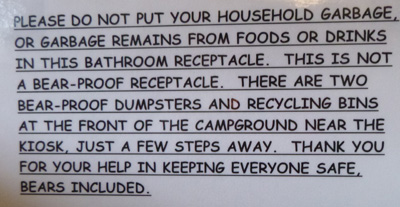
The author of this webpage, (written as a reading assignment for my students), does not give any warranty, expressed or implied, nor assume any legal liability or responsibility for the accuracy, completeness, or usefulness of any information, product, or process included in this website or at websites linked to or from it. Users of information from this website assume all liability arising from such use.
